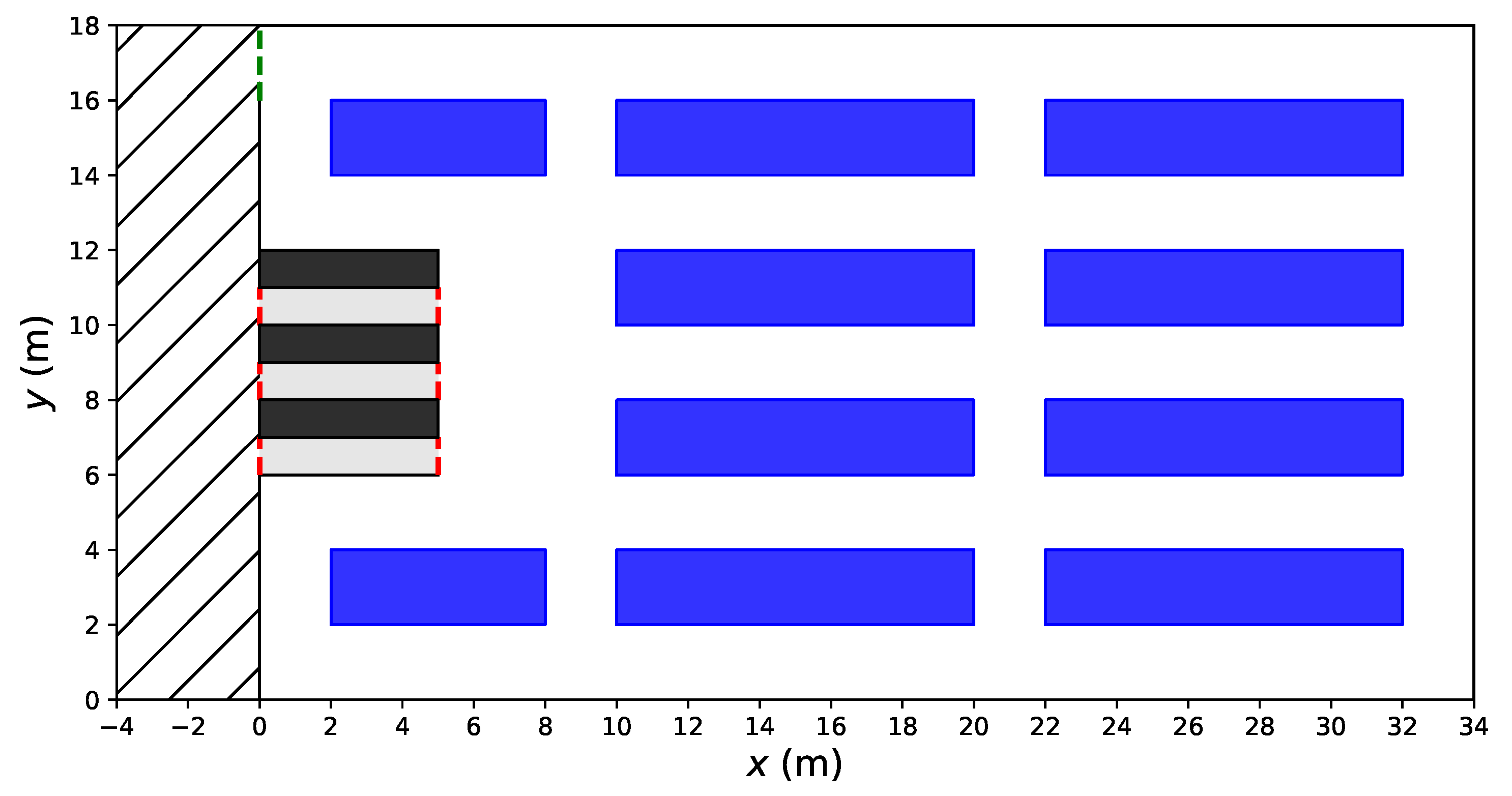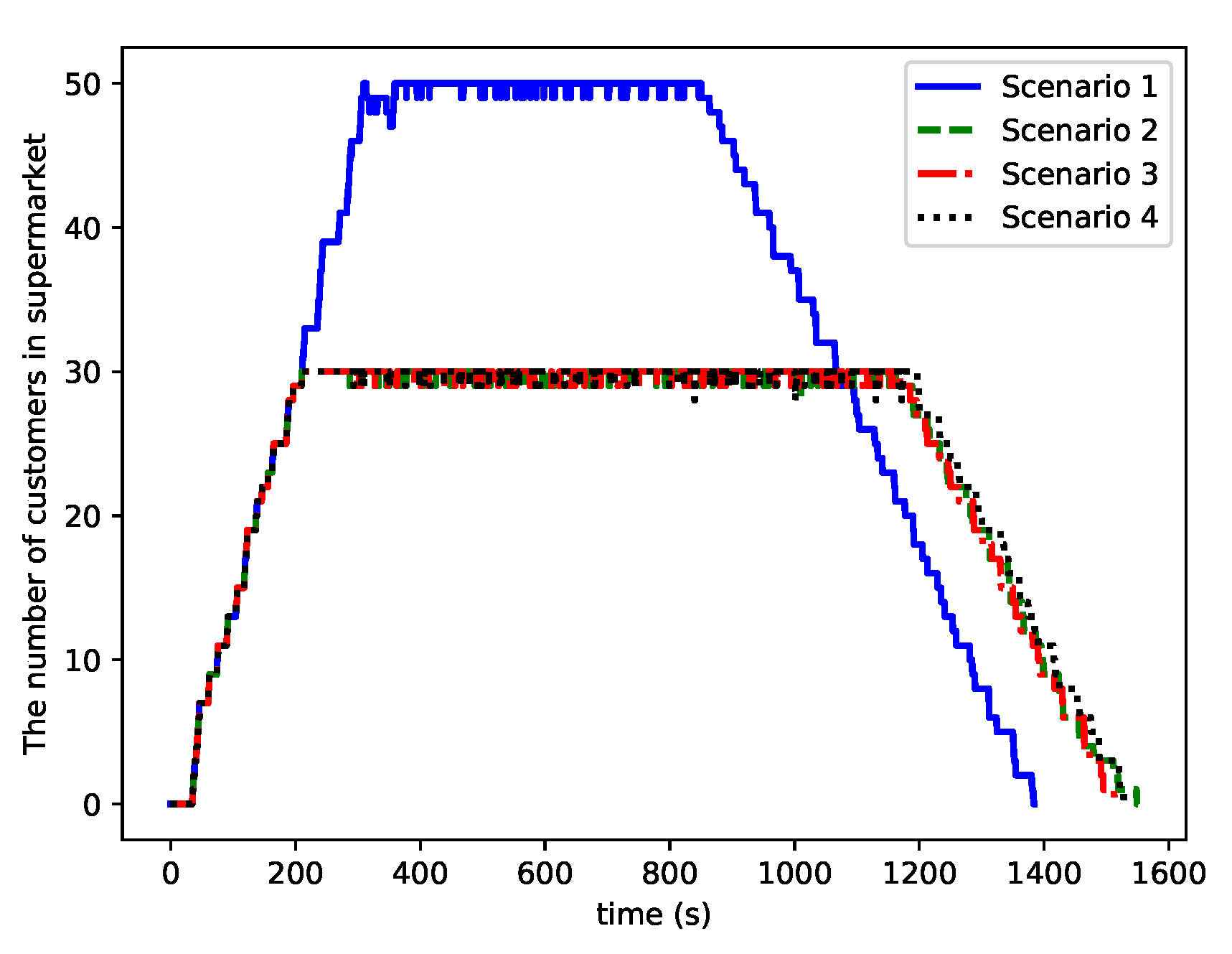On the Effectiveness of the Measures in Supermarkets for Reducing Contact among Customers during COVID-19 Period
Abstract
1. Introduction
2. Research Methods
2.1. How to Quantify Contact among Pedestrians
2.2. Simulation of Shopping Behavior in the Supermarket
3. Simulation Results
4. Conclusions
Author Contributions
Funding
Conflicts of Interest
Appendix A
| Parameters | Explanation | Values | |||
|---|---|---|---|---|---|
| Scenario 1 | Scenario 2 | Scenario 3 | Scenario 4 | ||
| k | The parameter to calibrate the strength of the impact from other pedestrians (Equation (2)) | 8 | |||
| D | The parameter to calibrate the scale of the impact from other pedestrians (Equation (2)) | 0.1 | 0.1 | 0.3 | 0.3 |
| (m/s) | The desired moving speed of customers (Equations (3) and (6)) | N∼ | |||
| T (s) | The parameter to calibrate the speed according to the gap between two pedestrians (Equations (3) and (6)) | 1 | |||
| The parameter to calibrate the checkout time according to the shopping time (Equation (5)) | 0.1 | ||||
| (m/s) | The parameter to calibrate the distance between customers in checkout area according to the shopping time (Equation (7)) | 0.03 | |||
| M (person) | The total number of customers generated in the simulation | 100 | |||
| P (person/min) | The number of customers generated every minute | 10 | |||
| (s) | The shopping time of customers | N∼ | |||
| (m) | The social distance | 0 | 0 | 1.5 | 1.5 |
| (person) | The max allowable number of customers in the supermarket at the same time | 50 | 30 | 30 | 30 |
| Need shopping cart | Decide the shape of customers in simulations (customers without shopping cart are represented by circles with r = 0.2 m, customers with shopping cart are represented by ellipses with semi-axes m and m.) | No | No | No | Yes |
| (s) | The size of time-step in simulations | 0.05 | |||
References
- World Health Organization. WHO Timeline—COVID-19. Available online: https://www.who.int/news-room/detail/27-04-2020-who-timeline---covid-19 (accessed on 29 June 2020).
- World Health Organization. WHO Coronavirus Disease (COVID-19) Dashboard. Available online: https://covid19.who.int/ (accessed on 29 June 2020).
- World Health Organization. Q&A on Coronaviruses (COVID-19). Available online: https://www.who.int/emergencies/diseases/novel-coronavirus-2019/question-and-answers-hub/q-a-detail/q-a-coronaviruses (accessed on 29 June 2020).
- World Health Organization. Novel Coronavirus (2019-nCoV) Advice for the Public. Available online: https://web.archive.org/web/20200126025750/https://www.who.int/emergencies/diseases/novel-coronavirus-2019/advice-for-public (accessed on 29 June 2020).
- Prem, K.; Liu, Y.; Russell, T.W.; Kucharski, A.J.; Eggo, R.M.; Davies, N.; Flasche, S.; Clifford, S.; Pearson, C.A.; Munday, J.D.; et al. The effect of control strategies to reduce social mixing on outcomes of the COVID-19 epidemic in Wuhan, China: A modelling study. Lancet Public Health 2020, 5, e261–e270. [Google Scholar] [CrossRef]
- Kraemer, M.U.; Yang, C.H.; Gutierrez, B.; Wu, C.H.; Klein, B.; Pigott, D.M.; Du Plessis, L.; Faria, N.R.; Li, R.; Hanage, W.P.; et al. The effect of human mobility and control measures on the COVID-19 epidemic in China. Science 2020, 368, 493–497. [Google Scholar] [CrossRef] [PubMed]
- Tian, H.; Liu, Y.; Li, Y.; Wu, C.H.; Chen, B.; Kraemer, M.U.; Li, B.; Cai, J.; Xu, B.; Yang, Q.; et al. An investigation of transmission control measures during the first 50 days of the COVID-19 epidemic in China. Science 2020, 368, 638–642. [Google Scholar] [CrossRef] [PubMed]
- D’Orazio, M.; Bernardini, G.; Quagliarini, E. Sustainable and resilient strategies for touristic cities against COVID-19: An agent-based approach. arXiv 2020, arXiv:2005.12547. [Google Scholar]
- Szczepanek, R. Analysis of pedestrian activity before and during COVID-19 lockdown, using webcam time-lapse from Cracow and machine learning. PeerJ 2020, 8, e10132. [Google Scholar] [CrossRef] [PubMed]
- Ronchi, E.; Lovreglio, R. EXPOSED: An occupant exposure model for confined spaces to retrofit crowd models during a pandemic. arXiv 2020, arXiv:2005.04007. [Google Scholar] [CrossRef] [PubMed]
- D’Orazio, M.; Bernardini, G.; Quagliarini, E. A Probabilistic Model to Evaluate the Effectiveness of Main Solutions to COVID-19 Spreading in University Buildings according to Proximity and Time-Based Consolidated Criteria. Res. Sq. 2020. [Google Scholar] [CrossRef]
- Kucharski, A.J.; Russell, T.W.; Diamond, C.; Liu, Y.; Edmunds, J.; Funk, S.; Eggo, R.M.; Sun, F.; Jit, M.; Munday, J.D.; et al. Early dynamics of transmission and control of COVID-19: A mathematical modelling study. Lancet Infect. Dis. 2020, 20, 553–558. [Google Scholar] [CrossRef]
- Berger, D.W.; Herkenhoff, K.F.; Mongey, S. An Seir Infectious Disease Model with Testing and Conditional Quarantine; Technical report; National Bureau of Economic Research: Cambridge, MA, USA, 2020. [Google Scholar]
- Barbarossa, M.V.; Fuhrmann, J.; Meinke, J.H.; Krieg, S.; Varma, H.V.; Castelletti, N.; Lippert, T. The impact of current and future control measures on the spread of COVID-19 in Germany. medRxiv 2020. [Google Scholar] [CrossRef]
- Hou, C.; Chen, J.; Zhou, Y.; Hua, L.; Yuan, J.; He, S.; Guo, Y.; Zhang, S.; Jia, Q.; Zhao, C.; et al. The effectiveness of quarantine of Wuhan city against the Corona Virus Disease 2019 (COVID-19): A well-mixed SEIR model analysis. J. Med. Virol. 2020. [Google Scholar] [CrossRef] [PubMed]
- Iwata, K.; Miyakoshi, C. A Simulation on Potential Secondary Spread of Novel Coronavirus in an Exported Country Using a Stochastic Epidemic SEIR Model. J. Clin. Med. 2020, 9, 944. [Google Scholar] [CrossRef] [PubMed]
- Fang, Z.; Huang, Z.; Li, X.; Zhang, J.; Lv, W.; Zhuang, L.; Xu, X.; Huang, N. How many infections of COVID-19 there will be in the “Diamond Princess”-Predicted by a virus transmission model based on the simulation of crowd flow. arXiv 2020, arXiv:2002.10616. [Google Scholar]
- D’Orazio, M.; Bernardini, G.; Quagliarini, E. How to restart? An agent-based simulation model towards the definition of strategies for COVID-19 “second phase” in public buildings. arXiv 2020, arXiv:2004.12927. [Google Scholar]
- Kai, D.; Goldstein, G.P.; Morgunov, A.; Nangalia, V.; Rotkirch, A. Universal masking is urgent in the covid-19 pandemic: Seir and agent based models, empirical validation, policy recommendations. arXiv 2020, arXiv:2004.13553. [Google Scholar]
- Xiao, Y.; Yang, M.; Zhu, Z.; Yang, H.; Zhang, L.; Ghader, S. Modeling indoor-level non-pharmaceutical interventions during the COVID-19 pandemic: A pedestrian dynamics-based microscopic simulation approach. arXiv 2020, arXiv:2006.10666. [Google Scholar]
- Xu, Q.; Chraibi, M.; Tordeux, A.; Zhang, J. Generalized collision-free velocity model for pedestrian dynamics. Phys. A Stat. Mech. Appl. 2019, 535, 122521. [Google Scholar] [CrossRef]
- Bosina, E.; Weidmann, U. Estimating pedestrian speed using aggregated literature data. Phys. A Stat. Mech. Appl. 2017, 468, 1–29. [Google Scholar] [CrossRef]
- Buchmueller, S.; Weidmann, U. Parameters of pedestrians, pedestrian traffic and walking facilities. IVT Schriftenreihe 2006, 132, 15. [Google Scholar] [CrossRef]
- Wagoum, A.U.K.; Chraibi, M.; Zhang, J.; Lämmel, G. JuPedSim: An open framework for simulating and analyzing the dynamics of pedestrians. In Proceedings of the 3rd Conference of Transportation Research Group of India, West Bengal, India, 17–20 December 2015. [Google Scholar]








| Parameters | Values |
|---|---|
| k | 8 |
| T (s) | 1 |
| 0.1 | |
| (m/s) | 0.003 |
| M (person) | 100 |
| P (person/min) | 10 |
| (m/s) | N∼ |
| (s) | N∼ |
| Scenario ID | (Person) | (m) | D (m) | Need Shopping Cart |
|---|---|---|---|---|
| 1 | 50 | 0 | 0.1 | No |
| 2 | 30 | 0 | 0.1 | No |
| 3 | 30 | 1.5 | 0.3 | No |
| 4 | 30 | 1.5 | 0.3 | Yes |
| Mean | Standard Deviation | Shapiro–Wilks Test | Paired t-Test | |||||
|---|---|---|---|---|---|---|---|---|
| −175.3000 | 26.8790 | 0.9798 | 0.8200 | −35.1211 | 0.0000 | |||
| −6.1125 | 16.1472 | 0.9666 | 0.4497 | −2.0385 | 0.0507 | |||
| −3.2083 | 18.0953 | 0.9709 | 0.5639 | −0.9548 | 0.3476 | |||
| 172.7929 | 11.7533 | 0.9828 | 0.8938 | 79.1711 | 0.0000 | |||
| 40.5942 | 5.8819 | 0.9755 | 0.6980 | 37.1660 | 0.0000 | |||
| −2.1007 | 7.5094 | 0.9426 | 0.1070 | −1.5065 | 0.1428 | |||
| Mean | Standard Deviation | Shapiro–Wilks Test | Paired t-Test (Wilcoxon) | |||||
|---|---|---|---|---|---|---|---|---|
| Area 1 | 0.1952 | 0.0907 | 0.6739 | 0.0000 | 0.0000 | 0.0000 | ||
| 0.0229 | 0.0135 | 0.9247 | 0.0355 | 0.0000 | 0.0000 | |||
| −0.0009 | 0.0052 | 0.9837 | 0.9140 | −0.8889 | 0.3814 | |||
| Area 2 | 0.2646 | 0.0663 | 0.9414 | 0.0994 | 21.5000 | 0.0000 | ||
| 0.0070 | 0.0285 | 0.9705 | 0.5527 | 1.3228 | 0.1962 | |||
| 0.0336 | 0.0257 | 0.9638 | 0.3851 | 7.0483 | 0.0000 | |||
| Area 3 | 0.1210 | 0.0316 | 0.9822 | 0.8799 | 20.5898 | 0.0000 | ||
| 0.0582 | 0.0167 | 0.9939 | 0.9996 | 18.7725 | 0.0000 | |||
| 0.0153 | 0.0133 | 0.9488 | 0.1566 | 6.1786 | 0.0000 | |||
| Area 4 | 0.3027 | 0.0774 | 0.9711 | 0.5688 | 21.0676 | 0.0000 | ||
| 0.2570 | 0.0520 | 0.9908 | 0.9946 | 26.6224 | 0.0000 | |||
| −0.0157 | 0.0587 | 0.9714 | 0.5795 | −1.4439 | 0.1595 | |||
Publisher’s Note: MDPI stays neutral with regard to jurisdictional claims in published maps and institutional affiliations. |
© 2020 by the authors. Licensee MDPI, Basel, Switzerland. This article is an open access article distributed under the terms and conditions of the Creative Commons Attribution (CC BY) license (http://creativecommons.org/licenses/by/4.0/).
Share and Cite
Xu, Q.; Chraibi, M. On the Effectiveness of the Measures in Supermarkets for Reducing Contact among Customers during COVID-19 Period. Sustainability 2020, 12, 9385. https://doi.org/10.3390/su12229385
Xu Q, Chraibi M. On the Effectiveness of the Measures in Supermarkets for Reducing Contact among Customers during COVID-19 Period. Sustainability. 2020; 12(22):9385. https://doi.org/10.3390/su12229385
Chicago/Turabian StyleXu, Qiancheng, and Mohcine Chraibi. 2020. "On the Effectiveness of the Measures in Supermarkets for Reducing Contact among Customers during COVID-19 Period" Sustainability 12, no. 22: 9385. https://doi.org/10.3390/su12229385
APA StyleXu, Q., & Chraibi, M. (2020). On the Effectiveness of the Measures in Supermarkets for Reducing Contact among Customers during COVID-19 Period. Sustainability, 12(22), 9385. https://doi.org/10.3390/su12229385






